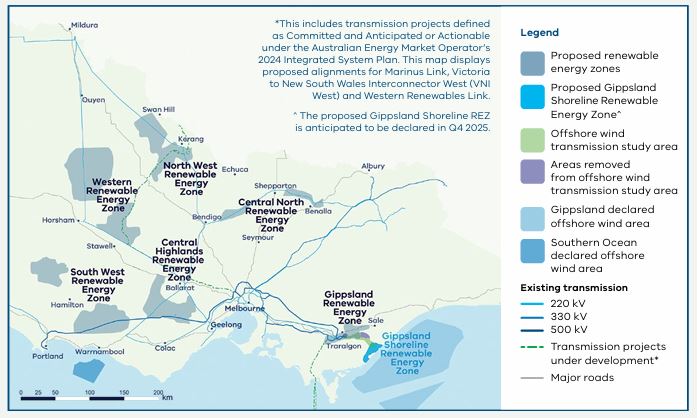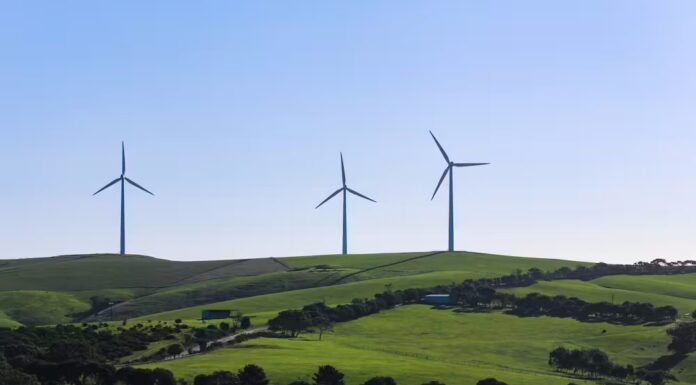Introduction
Victoria’s push towards renewable energy is a microcosm of global efforts to combat climate change, driven by state policies that align with Australia’s net-zero ambitions. The 2025 Victorian Transmission Plan, released in August, outlines a roadmap for six Renewable Energy Zones (REZs) spanning 1.88 million hectares, targeting 5,400 MW of new solar and wind capacity by year’s end {1}{2}. This builds on targets for 65% renewables by 2030 and 95% by 2035, supported by federal schemes like the Capacity Investment Scheme (CIS) [G3][G6]. Expert analyses highlight the economic ripple effects, with investments exceeding $14 billion by 2030, but also warn of risks like blackouts if coal retirements outpace infrastructure [G1]. Social media reflects mixed sentiments: optimism from advocates like officials praising job creation [G15], contrasted by skeptics questioning feasibility amid project cancellations [G17].
Renewable Energy Targets and Goals
At the heart of Victoria’s strategy are escalating targets: 40% renewable energy by 2025, 65% by 2030, and 95% by 2035, requiring 7.6 GW of rooftop solar by 2035 and 4 GW of offshore wind by that year {2}{3}{4}.

The state aims for 2 GW offshore by 2032, scaling to 9 GW by 2040, with REZs facilitating this growth {1}{2}. According to the Clean Energy Australia Report 2025, these goals are bolstered by rooftop solar already contributing 9.3% of generation [7]. Expert perspectives, such as those from energy analysts on social media, emphasize how these targets could lower bills, with Victoria’s power costs already competitive [G2][G4]. However, critics like commentator Craig Kelly argue that rapid transitions risk unreliability, citing recent wind project scrappings [G17]. Balancing this, the State Electricity Commission (SEC) pilots household electrification, mandating all-electric new homes from 2024 to boost solar uptake {4}.
Key Projects and Investments
Victoria’s transition is propelled by flagship projects, including the $453 million Kiewa Valley Battery Energy Storage System (BESS), a 500 MW facility fast-tracked in October 2025 to power 172,000 homes annually {5}. This joins 19 accelerated projects under the Development Facilitation Program, worth $5 billion and adding significant storage [5]. Offshore wind advances with the Gippsland REZ for undersea cables {1}{2}, while federal CIS has greenlit hybrids like EDP Renewables’ 1.7 GW solar-storage ventures [G11]. News reports note a “gold rush” in investments, with Q2 2025 approvals hitting 1.5 GW [G3], but social media posts highlight setbacks, such as RWE’s scrapped offshore farm, fueling debates on economic viability [G17][G20]. Positively, these initiatives create jobs—Kiewa Valley alone adds 80 construction roles—offering solutions to regional unemployment {5}[G7].
Battery Storage Developments
Battery storage is pivotal, with targets of 2.6 GW by 2030 and 6.3 GW by 2035 to stabilize the grid {3}{5}. Milestones include Victoria exceeding 1 GW simultaneous BESS charging in September 2025 [G13], and approvals for nearly 5 GWh, like the 1 GW Portland Energy Park [G9]. The Clean Energy Report details innovations in lithium-ion tech, enabling 8-hour storage for peak demand [7]. Experts like John Hanger on social media praise batteries for averting crises during high demand [G19], while trends point to virtual power plants from home batteries reducing transmission needs [G1]. Critically, over-reliance on short-duration batteries could falter in extreme weather, prompting calls for long-duration energy storage (LDES) diversification [G18]. Solutions under study include $102 million in pilots for advanced tech, integrating with rooftop solar {4}[G5].
Transmission and Infrastructure Challenges
Infrastructure upgrades are essential, with the 2025 Transmission Plan proposing transmission lines for REZs to integrate renewables {1}{3}{8}. This addresses intermittency, but faces viewpoints: supporters see it as key to 95% renewables {3}, while social media skeptics decry potential blackouts from coal phase-outs [G17]. The SEC’s public ownership of 4.5 GW capacity aims for reliability [G2], and federal support via CEFC promotes investments [6]. Constructive perspectives include community consultations in REZ planning to mitigate environmental impacts {1}, with original insights suggesting hybrid models could bridge urban-rural divides by localizing benefits.
Emerging Trends and Perspectives
Trends show a battery boom amid market volatility, with investors capitalizing on spot prices as renewables surge [G12]. Social media discussions mix enthusiasm for emission cuts [G20] with concerns over subsidies and reliability [G18]. Balanced views from experts note Victoria’s lead in fast-tracking, but warn of vulnerabilities without diverse LDES [G1]. Solutions include expanding CIS for hybrids and piloting AI-optimized grids to handle demand from sectors like data centers [G14].
KEY FIGURES
- Victoria targets 40% renewable energy by 2025, 65% by 2030, and 95% by 2035, with a goal of 5,400 MW of new solar and wind capacity by 2025[2][3][8].
- Plans include installing 7.6 GW of rooftop solar PV by 2035[4].
- Energy storage targets are 2.6 GW battery capacity by 2030 and 6.3 GW by 2035, enough to power about half of Victorian homes during peak demand[3][5].
- Offshore wind development aims for 4 GW capacity by 2035, with at least 2 GW by 2032 and up to 9 GW by 2040[2][3][4].
- The government has approved a $453 million Battery Energy Storage System (BESS) project (500 MW) in north-east Victoria, expected to supply power to around 172,000 homes annually[5].
- Six Renewable Energy Zones (REZs) cover about 1.88 million hectares (7.9% of Victoria’s land) for wind, solar, and storage projects[1][2].
RECENT NEWS
- The 2025 Victorian Transmission Plan was released in August 2025, outlining transmission upgrades and six REZs to support renewable energy growth over the next 15 years[1][3][8].
- In October 2025, the Victorian government fast-tracked the Kiewa Valley BESS, a $453 million battery project, to strengthen grid stability and support the 95% renewables target by 2035[5].
- Victoria’s Development Facilitation Program has accelerated 19 renewable projects worth over $5 billion, potentially powering 570,000 homes with significant battery storage capacity[5].
- The State Electricity Commission (SEC) is expanding public ownership of energy assets and piloting household electrification programs, supporting emissions reductions and renewable integration[4].
STUDIES AND REPORTS
- The 2025 Victorian Transmission Plan provides a strategic framework for developing REZs, transmission infrastructure, and battery storage, emphasizing community consultation and balancing environmental, social, and economic factors[1][3].
- The Clean Energy Australia Report 2025 highlights large battery projects like Rangebank BESS (200 MW / 400 MWh) in Victoria as key enablers of grid stability and renewable integration[7].
- Australian federal initiatives, including the Capacity Investment Scheme (CIS) and Clean Energy Finance Corporation (CEFC), supplement Victoria’s efforts by promoting investment in renewable generation and storage projects nationally[6].
TECHNOLOGICAL DEVELOPMENTS
- Large-scale battery storage projects, such as the Victorian Big Battery and the Kiewa Valley BESS, incorporate advanced lithium-ion and emerging storage technologies to balance supply and demand, stabilize the grid, and reduce blackout risk[3][5][7].
- Offshore wind infrastructure development includes a dedicated Gippsland Shoreline REZ for undersea cable connections, facilitating integration of offshore wind farms planned to reach up to 9 GW by 2040[1][2][4].
- Rooftop solar PV technologies are expanding rapidly, with incentives and regulations pushing new homes to be all-electric by 2024 to maximize renewable uptake[4].
MAIN SOURCES
- https://www.energy.vic.gov.au/renewable-energy/vicgrid/the-victorian-transmission-plan — Victorian Transmission Plan details and REZs {1}
- https://www.pv-magazine-australia.com/2025/08/18/victoria-plans-six-rezs-to-deliver-clean-energy-transition/ — Overview of six REZs and capacity targets {2}
- https://www.energy.vic.gov.au/about-energy/news/news-stories/2025-victorian-transmission-plan-released — Official announcement of the 2025 Transmission Plan {3}
- https://www.secvictoria.com.au/about/energy-transition-milestones — SEC milestones and renewable energy targets {4}
- https://www.invest.vic.gov.au/news-and-events/news/2025/october/victoria-fast-tracks-$453m-battery-project,-reflecting-new-opportunities-in-renewable-energy-investment. — Recent battery project approval and details {5}
- https://practiceguides.chambers.com/practice-guides/renewable-energy-2025/australia/trends-and-developments — Australian federal support for renewable and storage projects {6}
- https://cleanenergycouncil.org.au/getmedia/f40cd064-1427-4b87-afb0-7e89f4e1b3b4/clean-energy-australia-report-2025.pdf — Clean Energy Australia Report 2025, including battery projects {7}
- https://www.pinsentmasons.com/out-law/news/victorian-transmission-plan-released — Commentary on Victorian Transmission Plan release {8}
Other references :
energy.vic.gov.au – The Victorian Transmission Plan – Energy
pv-magazine-australia.com – Victoria plans six REZs to deliver clean energy transition
energy.vic.gov.au – 2025 Victorian Transmission Plan released – Energy
secvictoria.com.au – Energy transition milestones – SEC
invest.vic.gov.au – Victoria fast-tracks $453M battery project, reflecting new …
practiceguides.chambers.com – Renewable Energy 2025 – Australia – Global Practice Guides
cleanenergycouncil.org.au – [PDF] Clean Energy Australia Report 2025
pinsentmasons.com – New plan charts path forward for Victoria’s renewable energy transition
theguardian.com – Source
energy.vic.gov.au – Source
carboncredits.com – Source
premier.vic.gov.au – Source
invest.vic.gov.au – Source
victorianchamber.com.au – Source
invest.vic.gov.au – Source
energy-storage.news – Source
australianmanufacturing.com.au – Source
pinsentmasons.com – Source
power-technology.com – Source
reuters.com – Source
energy-storage.news – Source
energyglobal.com – Source



